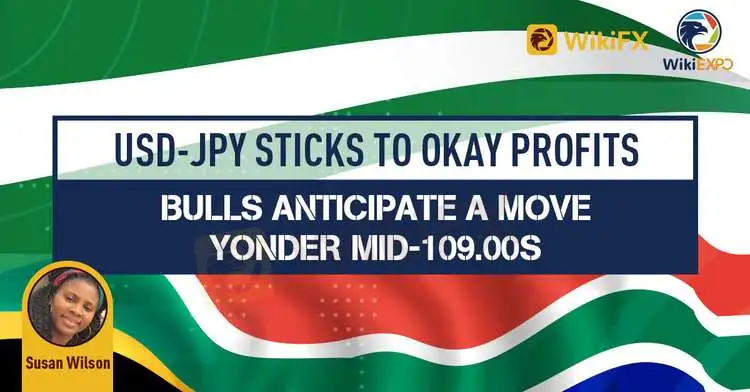简体中文
繁體中文
English
Pусский
日本語
ภาษาไทย
Tiếng Việt
Bahasa Indonesia
Español
हिन्दी
Filippiiniläinen
Français
Deutsch
Português
Türkçe
한국어
العربية
USD-JPY PRICE FORECAST: USD-JPY STICKS TO OKAY PROFITS, BULLS ANTICIPATE A MOVE YONDER MID-109.00S
Abstract:The fresh surge in USD-JPY seems to be delaying as it brawls to range the sequence of higher highs and lows succeeding the Fed interest rate decision, but the new regaining in the exchange rate eliminates the risk of a head-and-shoulders development as it breaches the left shoulder.

The fresh surge in USD-JPY seems to be delaying as it brawls to range the sequence of higher highs and lows succeeding the Fed interest rate decision, but the new regaining in the exchange rate eliminates the risk of a head-and-shoulders development as it breaches the left shoulder.

USD-JPY RATE RECOVERY ELIMINATES RISK OF HEAD-AND-SHOULDERS DEVELOPMENT
In a fresh speech, New York Fed President John Williams warns said that “we still have a lengthy way to go to realize a healthy and full economic recovery,” with the perpetual voting-member on the FOMC going onto say that the “healthy economic development this year by itself isn't sufficient to accomplish the very durable and full economic turn-around that we are aiming for.”
Consequently, Williams stresses that “it's significant not to overreact to this instability in prices ensuing from the unique situations of the covid19,” and it appears as though the Federal Reserve is in no haste to gauge back its emergency actions as “the statistics and circumstances we are witnessing now are not nearly adequate for the FOMC to change its monetary policy posture.”
The remarks recommend the Fed will hold on to a wait-and-see tactic as the central bank cautions of a fleeting increase in inflation.
Till then, USD-JPY may remain to study the swings in long-dated US yields though the FOMC remains on track to “surge our holdings of Treasury securities by a minimum of $80 billion per month,” but the current increase in the exchange rate may continue to overlap with the changed in retail sentiment as the flocking behavior from 2020 resurfaces.
TECHNICAL ANALYSIS
With that said, the plunge from the March high - 110.97- might reveal to be a retracement instead of a variation in trend as the crowding behavior from 2020 remerges, and the fresh retrieval in the exchange rate eliminates the threat of a head-and-shoulders development as it breaks above the left shoulder.
The Relative Strength Index (RSI) displayed a similar dynamic as the indicator scaled above 70 for the first time since February 2020, but the resistance from overbought territory has annulled the bullish trend from this year, with USD-JPY plunging below the 50-Day SMA (108.71) for the first time since January.

However, USD-JPY seems to have an upturned course in advance of the March low -106.37- as it trades back above the 50-Day SMA -108.71-, but need a break-close above the Fibonacci overlap around 109.40 (50% retracement) to 110.00 (78.6% expansion) to unleash the March high (110.97).
A breach above the March high (110.97) unlocks the intersection around 111.10 (61.8% expansion) to 111.60 (38.2% retracement), with the subsequent area of attention coming in around 112.40 (61.8% retracement) to 112.50 (38.2% retracement).
The short-term view for USD-JPY is bearish, with room for a sharper down ride once below the 108.70, the direct support level. In the 4-hour chart, the duo is hurrying its weakening below its 20 and 200 SMA, which nevertheless lack steering forte.

Disclaimer:
The views in this article only represent the author's personal views, and do not constitute investment advice on this platform. This platform does not guarantee the accuracy, completeness and timeliness of the information in the article, and will not be liable for any loss caused by the use of or reliance on the information in the article.
Read more

Key Forex Strategies
New to forex trading and looking for simple and effective trading strategies? We got you covered! In this quick guide, we'll explain some of the key forex strategies which are easy to digest. So, let's start!

Fundamental vs Technical Analysis
Fundamental and technical analysis play some of the most influential and critical roles in making trading decisions amongst traders today. They are widely accepted by stock, foreign exchange, indices and cryptocurrency traders worldwide. Traders use either or both of the methods to make key trading decisions in their respective markets.

Going Short of JPY Is Boosted by Yellen’s Remark on Interest-Rate Hikes Again
When interviewed by Bloomberg, Yellen, the U.S. Treasury Secretary, indicated that the USD 4-trillion budget released by Biden would be beneficial to America even if it may increase inflation and interest rates.

Brent oil is predicted of bullish repricing by Goldman Sach
According to Goldman Sachs' head of energy research, a nuclear deal between the U.S. and Iran could send energy prices higher - even if it means more supply in the oil markets. Talks are ongoing in Vienna between Iran and the six world powers - the U.S., China, Russia, France, U.K., and Germany - trying to salvage the 2015 landmark deal. Officials say there's been progress, but the conclusion of the negotiations remains unclear and oil prices have been soaring as a result.
WikiFX Broker
Latest News
Germany's Election: Immigration, Economy & Political Tensions Take Centre Stage
WikiFX Review: Is IVY Markets Reliable?
IG 2025 Most Comprehensive Review
Top Profitable Forex Trading Strategies for New Traders
EXNESS 2025 Most Comprehensive Review
New SEC Chair Paul Atkins Targets Crypto Regulation Reform
ED Exposed US Warned Crypto Scam ”Bit Connect”
Currency Calculator






